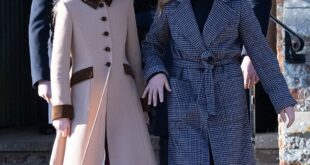He was the Eton-educated royal playboy who massacred nearly all his family after a row about the woman he wanted to marry.
On June 1, 2001, Crown Prince Dipendra of Nepal shot dead eight relatives, including his parents – the king and queen – and siblings before turning one of his weapons on himself at the family’s palace in Kathmandu.
Despite being in a coma with grievous head wounds, Dipendra, 29, was named as the new king – but ‘reigned’ for just three days before his life support machine was switched off.
Now, the troubled playboy’s motive for the killings that shocked the world is being explored in the penultimate episode of Daily Mail podcast series Queens, Kings and Dastardly Things.
Mail columnist and royal biographer Robert Hardman and his co-presenter Professor Kate Williams examine Dipendra’s long-held desire to marry Devyani Rana, the daughter of an Indian princess.
On June 1, 2001, Crown Prince Dipendra of Nepal shot dead eight relatives, including his parents – the king and queen – and siblings before turning one of his weapons on himself at the family’s palace in Kathmandu. Above: Crown Prince Dipendra examining an automatic rifle in a Pakistan ordinance factory

Princess Diana poses with King Birendra and Queen Aishwarya and their son, Crown Prince Dipendra during her visit to Nepal in March 1993
His mother, Queen Aishwarya, was particularly against the match, and on the night of her murder, she and her husband – King Birendra – had a stand-up row with Dipendra.
During his time at Britain’s most prestigious private school, he was given the nickname ‘Dippy’ and was known for his obsession with guns and martial arts.
Birendra had become the monarch in 1972 after the death of his father, King Mahendra.
Birendra willingly gave up some of his power to make his kingdom more democratic, but the move was unpopular with traditionalists in his family, including his wife and oldest son.
Princess Diana got on well with Dipendra when she visited Nepal in early 1993, a few months after she separated from Prince Charles.
Mr Hardman recounted how the royal went missing one evening during her visit, which was her first official trip after her separation.
The historian was told that she had gone off with Dipendra, who drove her around Kathmandu after getting the police to shut down all the roads.
On the night of the royal massacre, the family had come together for dinner at the Narayanhiti Palace in Kathmandu because it was the end of the week.
While discussing affairs of state, things ‘started to go wrong’, Mr Hardman says.

The royal family of Nepal poses for a photo at the Narayanhiti Royal Palace in Katmandu, Nepal. From left: Princess Shruti, King Birendra, Crown Prince Dependra, Queen Aishwarya and Prince Niranjan

King Charles, then the Prince of Wales, talking to Crown Prince Dipendra in Kathmandu during his visit in 1998

Charles is given a warm send off by Crown Prince Dipendra in Kathmandu at the end of his four-day visit, February 1999


Crown Prince Dipendra (pictured above in 1998) wanted to marry Devyani Rana (right)


The podcast is presented by Mail columnist and royal biographer Robert Hardman and historian Professor Kate Williams
Dipendra had a ‘huge standup row’ with his parents and then ‘gets up and he leaves the room.’
‘Instead of going off to stew in his apartments, the crown prince wasn’t letting this lie.
‘We know that he changed into fatigues. And there, suddenly, to everyone’s horror,
‘At the door of the room, there is the crown prince in military kit, and he’s armed, and he opens fire.
‘He shoots his father, his father the king, but then as other members of the family either rush forward or rush away, he starts to shoot them as well.’
Dipendra, who was armed with weapons including an MP5 submachine gun, a shotgun and a Colt carbine – even chased his own mother out of the room before executing her.

King Dipendra is taken for cremation in Kathmandu, wearing a flower on his forehead to hide the fatal bullet hole

A distraught mourner is held back in front of a picture of slain King Birendra and Queen Aishwarya on the street in Kathmandu, June 4, 2001

Pall bearers carry coffins with bodies of Nepal’s royal family through the river Bishumati for cremation in Kathmandu June 2, 2001

After Dipendra’s death in hospital, the Nepalese crown went to the king’s brother, Prince Gyanendra, who was the younger brother of Birendra

The Daily Mail’s coverage of the massacre, from June 2, 2001
As well as refusing to spare his brother and sister, Dipendra killed his aunts, one of his aunt’s husbands and a princess who was a cousin of the king.
‘By the end of this extraordinary, horrific act of regicide, it’s not just the king who lies dead, there are eight members of the royal family, and then he turns the gun on himself,’ Mr Hardman adds.
After Dipendra’s death in hospital, the Nepalese crown went to the king’s brother, Prince Gyanendra, who was the younger brother of Birendra.
Gyanendra, who had briefly ruled Nepal as king from 1950 to 1951 as a toddler, had not been at the fateful family dinner.
Like his nephew, he was opposed to the democratic reforms that had been enacted by his brother.
However, his rule proved deeply unpopular, ultimately leading to the abolition of the Nepalese monarchy in 2008.
But as for the role that Dipendra’s love for Devyani Rana played in his unfathomable decision to kill his whole family, listen to the latest episode of Queens, Kings and Dastardly Things to hear the verdict of Mr Hardman and Professor Williams.
Robert Hardman is the author of books including Queen of Our Times: The Life of Elizabeth II and Charles III: New King. New Court. The Inside Story.
Professor Kate Williams is the author of the recent book The Royal Palaces: Secrets and Scandals, along with many other works.
Source link



